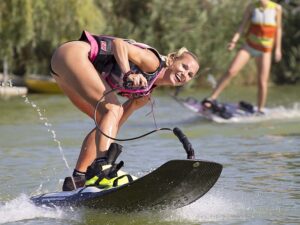You’ve finally mastered standing on a surfboard without wiping out and you can ride the waves straight to shore. The next level for your surfing skills is learning how to turn. Check out this guide for a few basic steps on turning while surfing.
You need to use both your body and feet to turn a surfboard. Generally, you start the turn by looking where you want it to go, then using your feet to pivot the board across the water. But there are some different types of turns that have their own special movements.
Maintaining Speed While Turning
When you aim your board at the wave in front of you, instead of going with the flow, it causes turbulence and makes riding more difficult.
The rough water is causing you to lose speed. The arch-enemy of surfboard turning is lack of speed. As a result, having sufficient pace before attempting to turn on a surfboard is essential.
To ensure that you have adequate speed to complete a turn, start your ride near the peak of the wave’s face. The most potent part of the swell is located here.
The Types of Surfboard Turns
There are several distinct varieties of surfboard turns, and each has a number of variants. The most fundamental, flexible forms of turns on a board are shown below.
The Frontside Cutback
The cutback is used to get back to the breaking part of the wave. After other turns and acrobatics, the cutback is used to swiftly cross the face of the wave and sharply turn around towards the curl.
Whatever your preferred stance is, you’ll be riding frontside for this turn (facing the wave with your chest).
How to Perform a Cutback
You’ll need a little more speed than you’d anticipate. When it’s time to put the board on its rails, we recommend setting your RPMs at 15 mph or closer to that.
Keep an eye on the top of the wave, bend your knees for stability, and quickly move your weight from the balls of your feet to your heels. Then rotate on your back foot while sweeping the surfboard in a counterclockwise direction.
Then, stretch your legs and move your weight back to the balls of your feet. Keep your balance on the board as you get ready for what comes next.
Tips for a Good Cutback
If you’re new to this move, start by doing it gradually. Do slower, sweeping cutbacks at first. With experience, you’ll be able to turn with a smaller radius. The size of the board also affects how tight of a turn you can make.
A longer board will increase your turning radius, while a shorter board will enable you to turn quicker.
The Bottom Turn
The bottom turn is one of the most essential turning techniques in surfing. It’s the turn that prepares your next move. After you’ve completed a trick, you make your way down the face of a wave by turning at the bottom to return to the face of the wave.
The bottom turn is critical to improve your surfing on a swell. Bottom turns aren’t difficult to master, and you’ll see surfers of varying abilities execute them.
How to Perform a Bottom Turn
Look ahead to where you want to do your bottom turn as you’re going down the face of a wave. As you get ready to turn, bend your knees.
When you’re at the bottom of the wave, distribute your weight to either your heels or toes, depending on whether you’re turning left or right (i.e., frontside or backside). Simultaneously lean into the direction that you want to go.
As your surfboard’s rail begins to dig in the water, swivel your body to the desired direction. You may also utilize your arms to assist you rotate your body. This will aid create momentum, allowing for a more effective bottom turn.
The best thing to do is to get into position and then leap onto the wave as it comes towards you. After that, you’ll be facing the front of the wave, and if done properly, you may climb up the slope ready for the next move or trick.
Bottom Turn Tips
You’ll want to take a more gradual approach than you would if performing a figure eight, for example.
If you want to improve your surfing skills, focusing on your bottom turn is important. Start slow and gradually build speed as you get more comfortable.
Trimming Turns versus Carving Turns
A trimming turn or a carving turn is any kind of surfboard maneuver. A surfer may perform a trimming turn by shifting weight to one side momentarily.
Trimming turns usually correspond with the natural movement of a wave, while carving is more dynamic and aggressive, involving quick movements from both your body and the board.
If you want to step up your surfing game, then you need to learn how to do both trimming and carving turns. The two types of turns work well together and are the key foundation skills for doing aerials, slashes, floaters, and other fun tricks.
Tips and Tricks for Turning on a Surfboard
- Speed is a crucial component of successful turning actions.
- The curl of the wave is resurrected when the cutback is performed.
- Bottom turns are usually executed to set up other tricks.
- Slight changes in weight distribution while trimming turns help create speed.
- Carving is a type of turn that is more intense and abrupt.
- To get a feel for how they’re done, start with slow, gradual turns.
- Close to the wave’s shoulder, practice turns.
